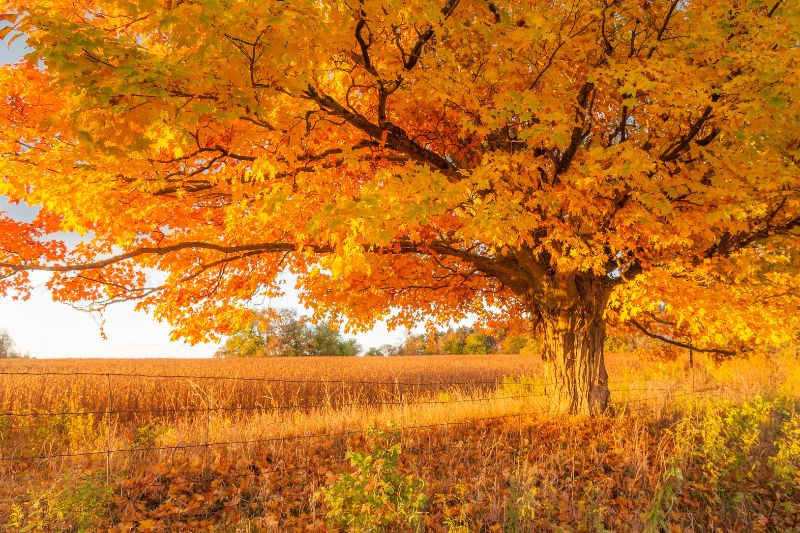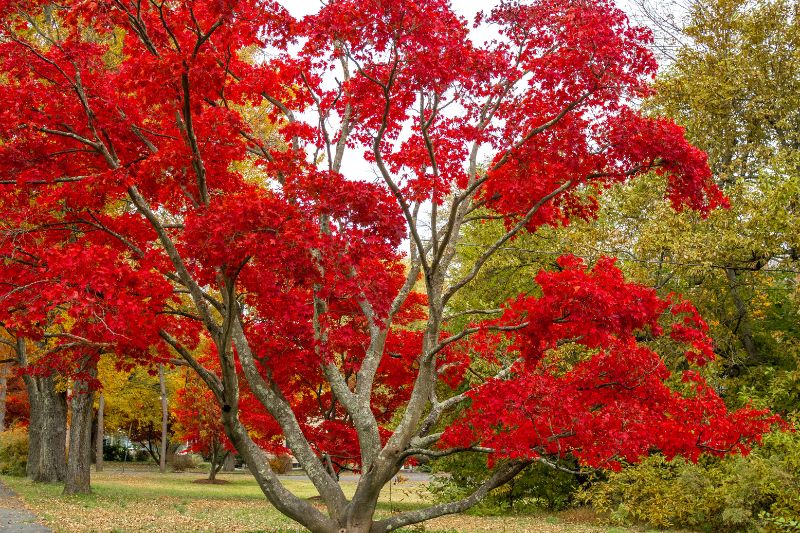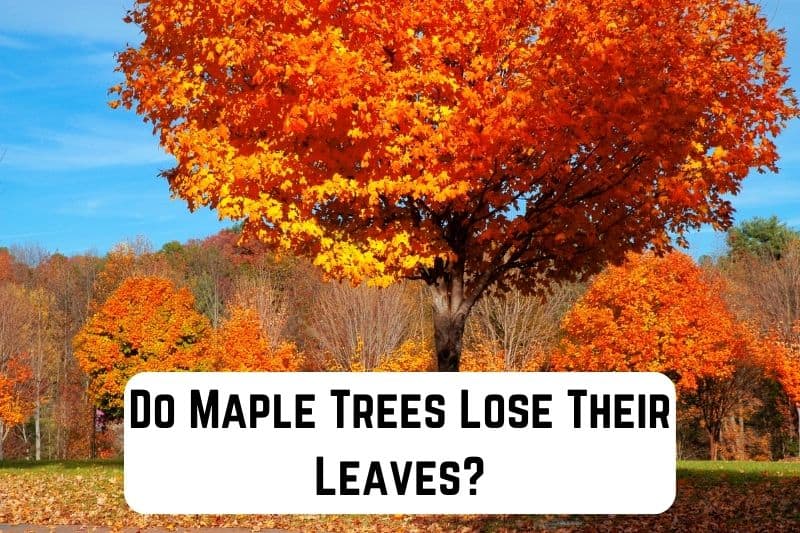Maple trees are popular for their invaluable benefits. They are a rich source of timber, the liquid gold, i.e. maple syrup, and most importantly, their most vivid red and orange interest during the northern forest fall seasons. But, do maple trees lose their leaves?
Fully understanding maple growth goes a long way to successfully cultivating its culinary, timber, and visual perks. The massive tree’s structural, root, and shoot system is perhaps the easiest way to gauge its health. Many underlying signs, including leaf behavior, can tell you whether or not a maple tree is healthy.
Whether leaves fall or not, and when they fall can tell you a lot about maple trees. Moreover, knowing their behavior lets you know what to expect when growing maple. This guide will help you answer the question of whether maple trees lose their leaves. Plus, it explains the implications behind maple tree leaf behavior.
Read: How Long Do Pecan Trees Live?
Do Maple Trees Lose Their Leaves?
It’s important to understand when and why maple trees lose their leaves. Moreover, leaf-shedding trees typically lose their leaves at a particular season, hinting at a health issue when they don’t shed them in the right season.
Maple trees routinely lose their leaves, like most deciduous trees. But, maple trees lose their leaves as a sign of being healthy and not otherwise. In fact, leaf loss in maple trees during the right time ensures new healthy growth in the subsequent season.
Maple tree leaf loss is part of the tree’s preparation to survive the harsh seasons. This allows the trees to enjoy new growth and continue to thrive better during more pleasant seasons. Ultimately, you get to enjoy a better supply of wood over time, delicious maple syrup, and vivid color contrasting interest during the leaf-shedding period.
When Do Maple Trees Lose Their Leaves?
Maple trees lose their leaves during the fall season. These broadleaf or deciduous trees lose their leaves during dormancy in colder seasons and allow newer and healthier growth in warmer periods.
Like most deciduous trees, maple trees go through a year round cycle – which includes losing their leaves in fall. As the weather gets cooler during fall, chlorophyll in the leaves dies. Chlorophyll is a critical plant component, as it plays an essential role in fueling photosynthesis by processing sunlight, water, and other important nutrients.

Moreover, the chlorophyll pigment is what gives leaves their signature green color. This explains why leaves change color and fall off during the “fall” season when chlorophyll dies. In addition to promoting better growth and protecting the trees in the cold, this fall process is responsible for giving maple trees their striking fall color interest. When chlorophyll dies in fall, maple leaves develop their characteristic orange to red color.
What Climate is Best For Maple Trees?
Maple trees thrive best in the cool midwest and northern climates in the U.S. and Canada. The broadleaf trees prefer cool and moist conditions, with winter temperatures between -40 and 0 degrees Fahrenheit and summers of 60 to 100 degrees Fahrenheit.
While the fall and winter seasons are dormancy periods for the tree, spring and summer seasons are essential for their growth.
Maple trees also grow well in asian regions – a good example is the Japanese maple. Interestingly, some maple tree species thrive in warmer southern US regions – with adequate afternoon sunlight protection. Further, non-sensitive maple tree species can survive the wet and foggy northwest and coastal US regions.
Why is My Maple Losing Leaves in the Summer?
Maple trees lose leaves in summer when they have a problem. The only acceptable period for maple trees to lose leaves is during fall and not before – not even towards the end of summer. Therefore, leaf fall in other seasons is a telltale sign of a problem.
Here are common reasons for maple leaf loss in summer;
Leaf Affecting Disease
Disease is a common reason for maple leaf loss in summer or spring. A healthy maple tree regrows large, abundant, and rich pigmented green leaves in spring and summer. So, if you notice leaf fall during this time, chances are the tree has a disease.
Common diseases that trigger leaf fall include verticillium wilt, tar spot, anthracnose, and maple decline. The first three diseases are variations of fungal diseases aggravated by soil conditions or extreme humidity. On the other hand, maple decline is a dieback of urban maple plantings or forests, usually aggravated by various factors, including environmental stress.
Remedies to these ailments include supplementing the trees with sufficient nutrition and providing adequate ventilation around the trees. However, if you still experience issues with the trees, agricultural extension officers or certified arborists can always help.
Poor Soil Conditions
Poor nutrition can lead to leaf loss. Poor tree nutrition is associated with unsuitable growing soil conditions. Issues such as soil pH(maples prefer slightly acidic soil), too much sand or debris, lack of water or excess drought, and even low mineral levels can affect the tree’s nutrient uptake and well-being.
Balancing the soil pH, boosting soil drainage, and amending the soil can help alleviate this problem. Consistent watering of the trees, according to their needs, is also essential for leaf health. Maple tree growers should also familiarize themselves with proper maple tree growing practices to create optimal growing conditions for their trees.
Poor Air Quality
Unsuitable air quality – whether pollution or excess air moisture – triggers leaf loss in maple trees. Maple trees prefer less humid conditions, like those in the Midwest or northern regions.
Accident & Trauma to the Tree
Accidents can lead to unintended damage or trauma to maple trees – leading to stress. This can be an accident as simple as a truck driver running into the tree trunk or prolonged trauma to the roots or barks by digging.
Extensive damage and prolonged trauma to these parts of the tree can manifest in stress and eventual leaf loss. Maple tree growers should protect their trees and reduce as much activity around as possible.

When Do Maple Leaves Grow Back?
Maple leaves grow back during spring. Maple trees follow a cycle that includes leaf regrowth during the warmer spring season. They regrow their leaves during spring and begin to fill up with chlorophyll. This, in turn, fuels photosynthesis to foster nourishment and further tree growth.
As the temperatures continue to rise through summer, leaves become more abundant, larger, and greener. As fall arrives, the temperature drops, killing the chlorophyll, prompting leaf color change, and ultimately leaf fall. Trees enter their low-growth dormancy period and the cycle continues.
Note: During the low growth period, the shoot system of the tree is inactive. However, the root system underground continues to be busy, although rates vary from plant to plant. During this time, the roots grow and develop to become stronger while retaining nutrients for the tree. This activity also preserves sufficient energy for the tree to support shoot growth and development in warmer spring and summer seasons.
How Do You Revive a Dying Maple Tree?
Comprehensive care is enough to revive a dying maple tree. Fortunately, the reason for your maple tree’s dying can usually be diagnosable. This makes it easy to know what to do to revitalize the tree. However, a dead maple tree cannot be revived. This is because the dead roots cannot be brought back to life, rendering the tree unsalvageable.
If you suspect your maple tree is on the verge of dying, you can always confirm this. Four significant factors signal a dying maple tree. These include;
- Discolored or coated leaves
- Extensive leaf loss
- cracked, peeled, or damaged barks
- Severely cracked, deformed, or dying branches
- Deformed structure
- Visible pest activity or fungal damage
- An overall unhealthy-looking maple tree
The first remedy to reviving a dying maple tree is diagnosing and treating the underlying issues. While some issues can be rectified, most may require professional help from a certified arborist. By the time the tree reaches the dying process, extensive damage would’ve been done to it.
Read: Do Lilies Need Full Sun?
While disease, pest infestation, and environmental stress are common perpetrators, age is another known cause. Unfortunately, there’s not much to do if age is the cause for your tree’s decline. Maple trees have a lifespan of 40 years. So, once it nears or hits this age mark, it’s normal for maple trees to start to decline. There’s not much you can do other than keep the tree comfortable.
Your efforts shouldn’t end there once you address the root cause of your tree’s decline and reverse the effects. This is an excellent opportunity to reinvigorate your tree care approach to prevent recurring problems.
Here are the best practices for keeping maple trees alive and healthy;
- Improve the conditions if environmental stress is the problem
- Enrich the soil with high quality fertilizer
- Water deeply and regularly
- Add mulch to retain soil moisture
- Prune the trees to boost air circulation
- In high traffic or urban areas with risks of accidents or damage, build a small shield or protection around the trees.






